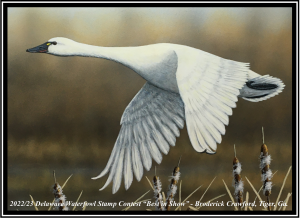A couple of participants in a Delaware youth waterfowl hunt head out from the duck blind to check their decoys.
Youth Waterfowl Hunt Set for Saturday, Oct. 16
Additional Delaware hunting seasons are set to open in October, including snow goose, duck, other migratory bird and firearm deer seasons, as well as the one-day, youth-only waterfowl hunt on Saturday, Oct. 16, the Delaware Department of Natural Resources and Environmental Control announced today. Deer hunting is allowed on all Sundays through Jan. 31, 2022, using only those hunting methods legal for the respective established deer hunting seasons, with additional information available at de.gov/sundayhunt.
Hunting season dates opening in October:
- Snow goose: Oct. 1 through Jan. 31, 2022; Feb. 5, 2022
- Antlerless deer: Oct. 1 through 3, Oct. 18, Oct. 22 through 25 and Oct. 29 through 31, including Sundays
- Muzzleloader deer: Oct. 8 through 17, including Sundays
- Youth Waterfowl Hunt: Oct. 16
- Ducks, coots and mergansers: first season split Oct. 22 through Nov. 1
Continuing hunting seasons include:
- Mourning dove: through Oct. 4
- Moorhen, gallinule, sora, Virginia rail, king rail and clapper rail: through Nov. 24
- Common snipe: through Nov. 27
- Archery and crossbow deer: through Jan. 31, 2022, including all Sundays
- Gray squirrel: through Feb. 5, 2022 (closed during November shotgun deer season)
- Coyote: through Feb. 28, 2022
- Crows: through March 26, 2022 (Thursdays, Fridays and Saturdays only)
- Groundhog: through June 30, 2022
The DNREC Division of Fish and Wildlife offers many hunting opportunities on state wildlife areas. For more information, visit de.gov/wamaps.
A Delaware hunting license or License Exempt Number (LEN) is required to hunt, and most waterfowl hunters are required to purchase a Delaware waterfowl (duck) stamp and a Federal Duck Stamp. Migratory bird hunters, except crow hunters, also need a Federal Harvest Information Program (HIP) number, which can be obtained through the DNREC ePermitting website or by calling toll free 855-DEL-HUNT (855-335-4868). If using the DNREC ePermitting system, hunters should either create a profile or use the “Quick Hunting Registration” option.
Registered motor vehicles used to access designated wildlife areas owned or managed by the DNREC Division of Fish and Wildlife are required to display a Conservation Access Pass (CAP). Hunters can opt to receive one free annual CAP with the purchase of any Delaware hunting license. To obtain a CAP, hunters will need the registration card for the vehicle to which the pass will be assigned.
Delaware hunting licenses, Delaware waterfowl stamps and Conservation Access Passes can be purchased online at de.gov/huntinglicense or from hunting license agents statewide. Hunters obtaining a LEN are reminded that they should create a profile using the DNREC ePermitting system portal or obtain a LEN at a hunting license agent if they have not already done so. Federal Duck Stamps can be purchased at U.S. Post Offices, Bombay Hook and Prime Hook national wildlife refuges, and online at 2021/2022 Migratory Bird Hunting and Conservation Stamp.
Additional information on hunting seasons and wildlife areas is available in the 2021/2022 Delaware Hunting & Trapping Guide or by calling the Wildlife Section at 302-739-9912. Information on hunting licenses, the state waterfowl stamp and the Conservation Access Pass is available at de.gov/huntinglicense or by calling the Recreational Licensing office at 302-739-9918.
About DNREC
The Delaware Department of Natural Resources and Environmental Control protects and manages the state’s natural resources, protects public health, provides outdoor recreational opportunities, and educates Delawareans about the environment. The DNREC Division of Fish and Wildlife conserves and manages Delaware’s fish and wildlife and their habitats, and provides fishing, hunting, wildlife viewing and boating access on nearly 65,000 acres of public land. For more information, visit the website and connect with @DelawareDNREC on Facebook, Twitter or LinkedIn.
Media Contacts: Michael Globetti, michael.globetti@delaware.gov, or Nikki Lavoie, nikki.lavoie@delaware.gov
###
